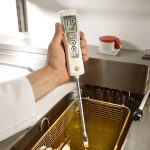Restaurants, abattoirs, farms and other businesses participating in Australia’s food economy use cold storage rooms and assets to maintain products over varying periods of time.
Last year, the International Association of Refrigerated Warehouses (IARW) released a report showing that the world’s total capacity of refrigerated warehouses grew 20 per cent between 2012 and 2014. Dr Victoria Salin, a professor at Texas A&M University’s Department of Agricultural Economics, wrote the report.
“While retailing sectors are the direct business connections between temperature-controlled warehousing and consumers in any country, the status of the transportation system is an enabling condition for both retailing and distribution,” said Dr Salin.
Obviously, administrators need to maintain these facilities appropriately. Using approved cleaning materials and installing remote temperature monitoring instruments are two measures these professionals can take. What are some other considerations decision makers need to action?
 Cheese and meats are a few foods that require cold storage.
Cheese and meats are a few foods that require cold storage.1. Implement systems to identify hazards
The New Zealand Food Safety Authority (NZFSA) released a Code of Practice for Cold and Dry Stores, outlining the concerns contractors, facility owners and other personnel should be cognisant of. Although the document is exclusive to NZ, there are many lessons food companies in Australia could take from it.
The guideline outlines several factors and/or actions cold storage facility administrators need to be aware of:
- Building design, construction and maintenance
- Potable water
- Cleaning and sanitation
- Employee abilities, health and hygiene
- Chemical control
- Pest mitigation
Under each of the aforementioned points, NZFSA outlined elements that introduce hazards. For instance, under chemical control, the authority noted that maintenance compounds such as cleaning products, lubricants and pesticides all pose risks.
Testo guide to Food Safety part 1 – Obligations for food traders and HACCP https://t.co/ccm4h5ooaQ pic.twitter.com/jL3CdM29EG
— Testo UK (@TestoLimited) December 2, 2015
To mitigate the dangers associated with food storage environments, managers could employ processes recommended under the Hazard Analysis Critical Control Point (HACCP) system. HACCP is a set of best practices that enable those in the food sector to iteratively identify and eliminate factors that may introduce health risks.
2. Humidity
In cold storage facilities, condensation can pose a number of risks, particularly when those environments are designed to store food.
Polygon Group, which produces desiccant dehumidification systems, noted that high relative humidity levels can cause mould, bacteria or even insect contamination. Escherichia coli and salmonella are two pathogens that can live for quite some time in food storage areas, especially if those rooms are moist.
Companies can prevent excessive humidity by ensuring wall temperatures and low ventilation systems are operating appropriately. Checking fridges and freezers with humidity measurement instruments on a regular basis can also help administrators indicate and isolate HVAC problems.
3. Energy usage
Although not a requirement, implementing protocols that systematically reduce energy consumption can go a long way in boosting an operation’s competitiveness, if not simply decrease costs. The International Association of Refrigerated Warehouses and the International Association for Cold Storage Construction released a guideline outlining how companies can build facilities according to the LEED rating system, which recognises buildings for power efficiency rates.
#cold_room doors reduce your energy consumptions minimum %20 at your cold storage warehouse.it is smart way to… https://t.co/4rKkJFA8lW
— shipyarddoor (@shipyarddoor) December 5, 2015
The guide provided specifications that can serve as a baseline for structures of varying sizes and applications. For instance, chill coolers sustaining temperatures between -4 and 0 degrees Celsius must have flooring with a baseline thermal resistance of 3.5 kilowatts (kW) per cubic metre (m2).
In addition, administrators should consider using refrigerant leak detectors on a regular basis to ensure the cold storage facility’s HVAC system is not suffering from defects. Refrigerant leaks can compromise a storage environment’s effectiveness.
What’s the big picture?
Above all else, cold storage managers must implement protocols such as those under the HACCP system. This program enables companies to systematically address hazards and prevent such dangers from compromising food product quality and integrity.
If you’d like to know which instruments can help you gather information about your cold storage rooms, contact Testo today.









 Reduce cooking oil costs while ensuring quality
Reduce cooking oil costs while ensuring quality Expert knowledge on CO2 monitoring
Expert knowledge on CO2 monitoring Refrigeration knowledge - in 3 modules
Refrigeration knowledge - in 3 modules



